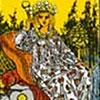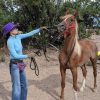If Zum does what I ask, I know I can continue what I am doing and make progress. If Zum doesn’t do what I ask, I need to back up and try to do something I know Zum will do willingly to praise him!
Month: September 2019
Listen
Crowd
Zum will crowd me and try to step on me sometimes when I lead him with his lead rope. I cannot let him do this but if I push him out of my way or yell at him unjustly, he will get angry with me. I have learned that I cannot teach an angry colt anything until he relaxes. So I immediately get Zum to do something I can praise him for so he can relax.
Alert
Goal
I always make sure that my major goal of keeping Zum’s attitude respectful and cooperative is never lost just to achieve an objective goal. I never sacrifice Zum’s willing attitude simply for a performance accomplishment. If I keep Zum’s trust in me as the priority, I am always amazed at how Zum gradually accepts something like a scary balloon!
Balloon
When I am riding a horse on the trail, I often see a balloon stuck in a tree or cactus. When I am riding in a neighborhood, I see that people often tie balloons on posts or mailboxes to signal a special event. Zum needs to learn to stay calm even around strange blowing objects like balloons. Zum has never seen a balloon before! When I introduced Zum to a balloon, he was jumpy and uneasy!
Yield
Even if Zum doesn’t do what I ultimately want, I reward him each time he tries. There is body language that I can use that rewards him for his attempt to get it right. I back away from him, step to the side or look down. If I don’t reward him through yielding, I kill Zum’s incentive to comply. Even the slightest hint of Zum trying to do what I request is reason for me to reward him with a release of pressure. This is my yield of respect to Zum.
Reward
Ropes
Zum doesn’t like things behind his ears. To train him to let me easily put his headstall on and off, I need to teach him that ropes on his head are not frightening. I always reward successive approximations to the final behavior that I desire. Eventually Zum will get to the calm place I want. I am shaping Zum with reward. I am his sculptress!





















